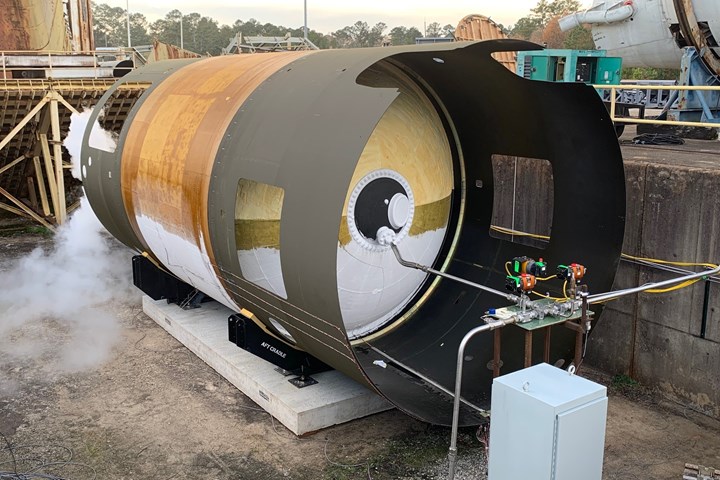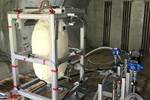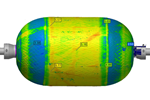Boeing all-composite cryogenic fuel tank proves technology readiness
Ultra-lightweight tank passes critical test campaigned by NASA, intended for a variety of aerospace applications and beyond.

Boeing’s all-composite cryogenic fuel tank undergoing pressure testing at NASA’s Marshall Space Flight Center. Photo Credit: Boeing
A new type of large, fully composite, linerless cryogenic fuel tank, designed and manufactured by (Chicago, Ill., U.S.) passed a critical series of tests at NASA’s Marshall Space Flight Center (Huntsville, Ala., U.S.) at the end of 2021. The successful test campaign proves the new technology is mature, safe and ready for use in aerospace vehicles, Boeing says.
The 4.3-meter (14-foot) diameter composite tank is similar in size to the fuel tanks intended for use in the upper stage of NASA’s Space Launch System (SLS) rocket, which is the foundational capability in NASA’s Artemis lunar and deep space human exploration program. If the new composite technology were implemented in evolved versions of the SLS’s Exploration Upper Stage, the weight savings technology could increase payload masses by up to 30%.
“Composites are the next major technological advancement for large aerospace cryogenic storage structures,” says Boeing Composite Cryotank Manufacturing Lead Carlos Guzman. “And while they can be challenging to work with, they offer significant advantages over traditional metallic structures. Boeing has the right mix of experience, expertise and resources to continue to advance this technology and bring it to market in a variety of applications across aerospace and aeronautics.”
During the testing, which was funded by the Defense Advanced Research Projects Agency (DARPA, Arlington County, Va., U.S.) and Boeing, engineers from Boeing and NASA filled the vessel with cryogenic fluid in multiple test cycles, pressurizing the tank to expected operational loads and beyond. In the final test, which intended to push the tank to failure, pressures reached 3.75 times the design requirements without any major structural failure.
“NASA’s support through this testing has been invaluable,” adds Boeing Test Program Manager Steve Wanthal. “We were able to use their technical expertise and investments made in the testing infrastructure at the Marshall Space Flight Center to continue to advance this technology, which will ultimately benefit the entire industry.”
Applications for the technology expand past spaceflight, Boeing says. The test which builds upon Boeing’s extensive experience with the safe use of hydrogen in aerospace applications will inform Boeing’s ongoing studies of hydrogen as a potential future energy pathway for commercial aviation. In addition to use in space programs, Boeing has completed five flight demonstration programs with hydrogen.
Related Content
-
Improving carbon fiber SMC simulation for aerospace parts
Simutence and Engenuity demonstrate a virtual process chain enabling evaluation of process-induced fiber orientations for improved structural simulation and failure load prediction of a composite wing rib.
-
Collier Aerospace HyperX optimizes X-59 composite nose cone
Swift Engineering relied on the CAE software’s structural sizing, analysis and test validation capabilities to deliver flight hardware for NASA’s supersonic QueSST aircraft early, under budget and with 25% weight savings.
-
Aurora reveals latest SPRINT X-Plane design concept
An Aurora and Boeing team advances its high-speed, vertical lift concept to the preliminary design phase, which features three lift fans, a more refined composite exterior and an uncrewed cockpit.






